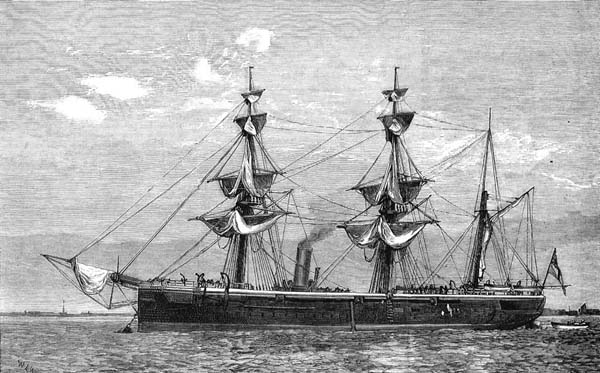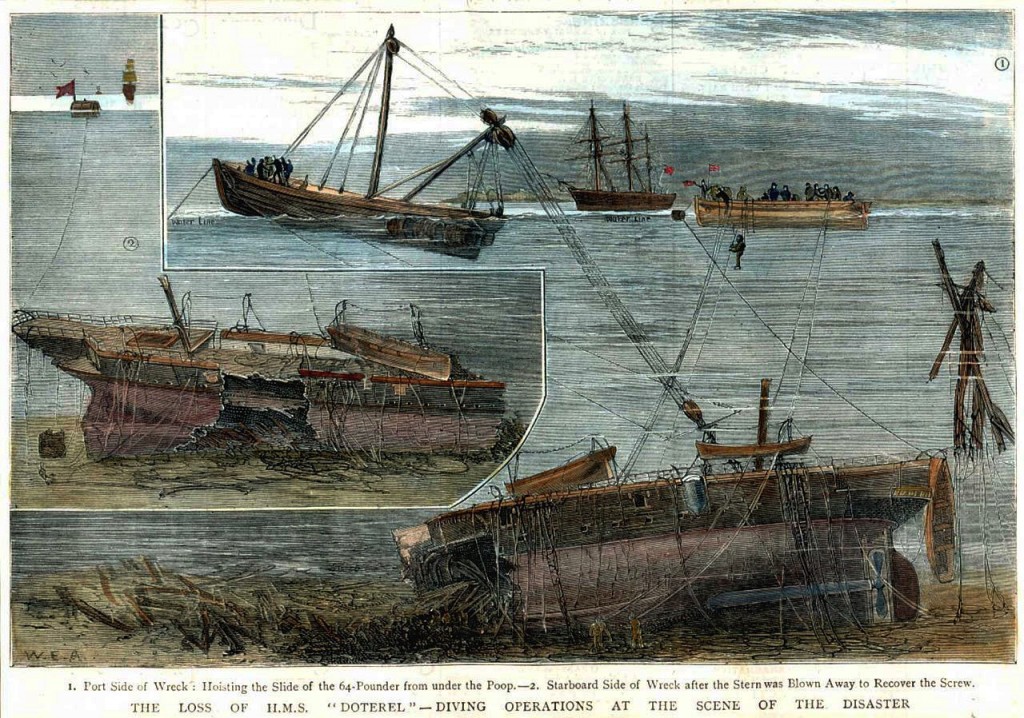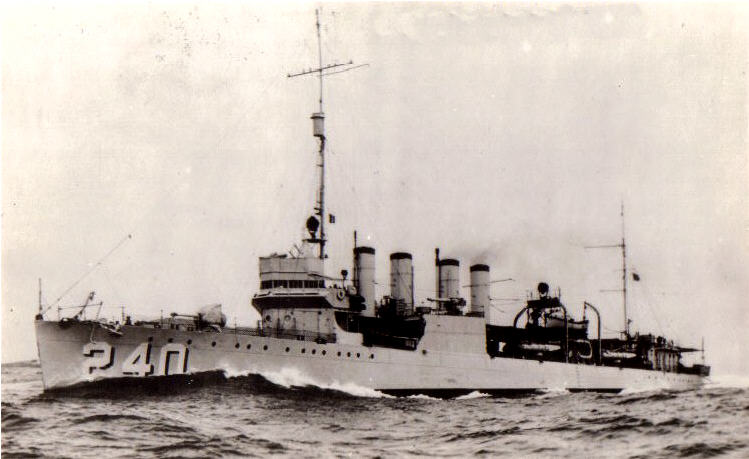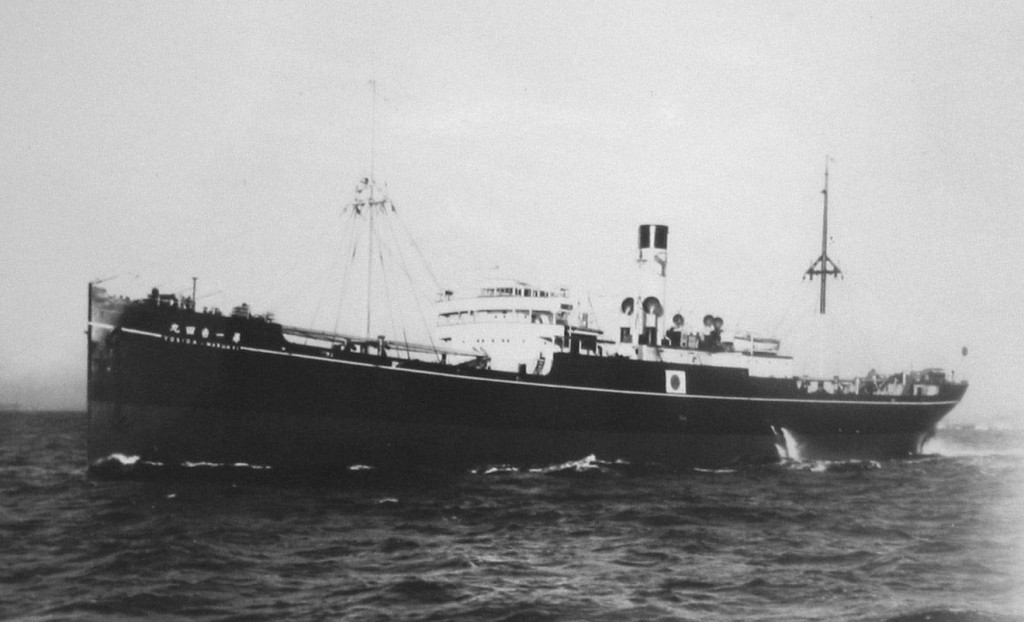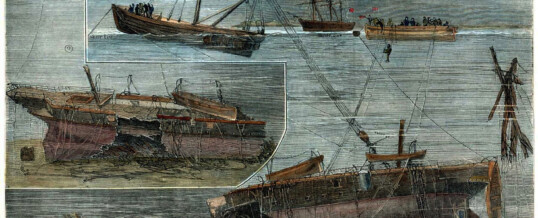
Today’s Shipwrecks™ list includes a Spanish frigate that had carried a shipment of silver coins; an English warship who’s guns were salvaged; a U.S. steamer that had been captured, used and scuttled by the Confederates; and a Japanese transport that went down with 2,669 people. The important question for this day is “did a ton of gold go down with the SS Colin?” If you are seeing this in a post, other than on Shipwrecks.com, read more about these wrecks and other ships lost on an April 26 at http://shipwrecks.com/shipwrecks-of-april-26/.
Today’s Shipwrecks™
April 26
compiled and edited by Dr. E. Lee Spence
1736: A group of six young men who had been on a pleasure trip to Sullivan’s Island, South Carolina, on April 26, 1736, had the yawl they were in “over set” and sink “the seas being very high, and the wind blowing hard,” and “being about halfway the river and opposite the fort”. Mr. Carwithen the pilot, Benjamin Potter, Robert Hall and a negro who was with them were drowned. The other four young men were taken up by a boat from HMS Rose. The yawl was owned by Captain Potter.
1751: The brigantine Elizabeth, Captain William Nicholls, bound from Philadelphia for Charleston, ran ashore near Bull’s Island, South Carolina, on April 26, 1751. It was expected that both the brigantine and her cargo would be lost.
1797: Two Spanish frigates, each of 36 guns, which were bound from Havana, Cuba to Cadiz, Spain, with a shipment of silver coins, were trapped and defeated on April 26, 1797, off the Spanish town of Conil de la Frontera on the Atlantic coast in the southern part of Spain by the British ship of the line HMS Irresistible, 74 guns, and the Fifth-rate frigate HMS Emerald, 36 guns.
The Spanish frigates surrendered after a brief engagement fighting anchored broadside to broadside in which the Spanish suffered significantly higher casualties than the British. Although she had already surrendered, the crew of the Santa Elena hacked through her anchor cables allowing her to drift onto the rocky shoreline where her men got off and escaped inland. The other captured frigate was the Ninfa, which was later recommissioned into the Royal Navy.
The British immediately towed the Santa Elena off the rocks with the intention of salvaging her, but, despite their efforts, she sank soon afterwards in the deeper water of Conil Bay. Unless some treasure was hidden on the Santa Elena, there is none to be found, as the British believed it had been completely off-loaded and carried to safety by a Spanish fishing boat shortly before the battle.
1817: The smack Mary, Captain Cooper, bound from Charleston, South Carolina, to Savannah, Georgia, was towed into the entrance of Port Royal Sound, South Carolina, in distress on April 26, 1817, but was blown out again in a gale. She was said to have been very leaky and her sails all split. She was cut adrift after having her crew and most of the materials taken out by the schooner Tobias, Captain Coombs. The Mary had lost one man overboard in the gale.
1822: The Canadian ship Harriet, Captain Hitchins, bound to Halifax from Jamaica, was wrecked on the Mira Por Vos Keys in the Bahamas on April 26, 1822. Her crew was saved.
1822: The wreck of an unidentified brig was seen “on Ackland Key, (Bahamas) with her main mast gone, & had apparently got on shore the night previous” (meaning April 26, 1822).
1833: The Tweed, bound from Jamaica to Halifax, Canada, was totally lost on Inagua Reef in the Bahamas prior to April 26, 1833. Her crew and cargo were saved.
1839: The brig Commodore Tucker, Captain Barlow, bound from Camden, New Jersey for New Orleans, was totally lost, with her cargo, on Abaco in the Bahamas on April 26, 1839. Her “rigging, sails, anchors, chains, etc., saved.”
1850: The Spanish ship Esperance, 500 tons, bound from St. Jago de Cuba for Barcelona, with a valuable cargo of sugar and rum and some money, was totally wrecked near Inagua during a severe gale on April 26 or 27, 1850. Her captain and crew were saved.
1857: The French brig Charles, Captain L’Eveque, bound from Haiti to Havre, “with 2,400 bags of coffee, was wrecked at Acklin’s Island” in the Bahamas in late April of 1857. Some of the cargo was carried to Nassau by the wrecks. The captain and crew were reported safe.
1862: The USS Huron ran an unidentified schooner ashore at Bull’s Bay, South Carolina, on April 26, 1862. The Federals attempted to board the schooner with their boats, “but the sea was so high and the wind blowing so strongly from the northeast that the boats could not approach her.” “She, however, was thumping heavily on the beach, with the sea breaking over her.”
1862: On April 26, 1862, the schooner Chase, of Nassau, was chased ashore by the United States steamer Huron near the middle of Raccoon Key (incorrectly described in the account as the island on which the Cape Romain light stands) and set on fire by her own crew to prevent its capture. The heavy surf extinguished the fire and she was boarded the following day by a boat from the U.S. ship Onward who attempted to save her (and described her as registered as twenty tons but seeming much larger by American standards). The Federals were planning to burn her if their efforts to get her off proved unsuccessful. (Note: Raccoon Key is near the entrance to Bull’s Bay, so this may or may not have been the unidentified schooner described in the previous entry.)
1862: The USS Monticello received a dispatch from the USS Jamestown on April 26, 1862, bringing news of a “rebel steamer being ashore on the bar at New Inlet (North Carolina), and orders” to get underway with the USS Victoria and proceed around the shoals to New Inlet. Upon arriving, they saw a large side-wheel steamer showing English colors lying in the river below Zeek’s Island, and apparently aground. The steamer proved to be the famous blockade runner/privateer Nashville. The Nashville got off, but was later wrecked in the Seven Mile Bend section of the Ogeechee River near Fort McAlister, Georgia. (Note: Persons interested in learning more about the Nashville should read Dave Topper and Frank and Paul Chance’s excellent book Tangled Machinery and Charred Relics.)
1881: On April 26, 1881 while at anchor off Punta Arenas, Chile, an explosion occurred in the forward magazine of HMS Doterel. Eyewitnesses described how objects of every type were thrown high into the air and a huge column of smoke was seen to rise from the ship. She sank instantly, killing 6 officers and 139 men. Her captain, rescued naked from the blast and bleeding from several wounds, was one of just a dozen survivors. Only three bodies were recovered intact.
The Doterel, launched in 1880, was the namesake of her class and a development of the 1874 Osprey-class sloop. The graceful clipper bow of the Ospreys was replaced by a vertical stem and more powerful engines were employed giving her a top speed of 11 knots. Her hull was of composite construction, with wooden planks over an iron frame. Power was provided by three cylindrical boilers, which supplied steam to a two-cylinder horizontal compound-expansion steam engine driving a single 13-foot-1-inch propeller.
Her guns, screw and other valuable fittings were salvaged. HMS Doterel was armed with two 7-inch muzzle-loading rifled guns on pivoting mounts, and four 64-pounder muzzle-loading rifled guns (two of which were on pivots, and two were mounted broadside). Four machine guns and one light gun completed the weaponry. Although described as a sloop because of her armament, she was barque rigged. In other words, she had square-rigged foremast and mainmast, and fore-and-aft sails only on her mizzen mast.
1883: Government records show the steamer Reliance as lost on April 26, 1883 but they fail to state the location or the cause of her loss, or whether any lives were lost. One reason this particular steamer is interesting is that she was the former USS Reliance, which had been captured on the Rappahannock River on August 19, 1863, and was operated briefly by the Confederates who, wanting to prevent her recapture and use by the Federals, stripped her and scuttled (sunk) her at Port Royal, Virginia, on August 28, 1863. Despite the Confederate attempts to destroy the steamer, she was raised and on January 26, 1867 she was redocumented.
The tug Reliance, official number 21956, was built by B.C. Terry at Keyport, New Jersey, and was launched June 4, 1860. Her first home port was New York, New York. She was acquired by the United States Navy Department from A. Degroot, on May 7, 1861, at a cost of $15,000, and was commissioned on May 13, 1861. She was a wooden hulled, screw steamer of 90 tons burden, with one boiler and two vertical direct acting engines with 17″ cylinders. As a navy vessel she was armed with one 24-pounder pivot howitzer and one 12-pounder pivot howitzer (or one 30-pounder Parrott and one 24-pounder howitzer). Her guns were removed before she was “destroyed.” In 1865 the Reliance was raised, sold, and returned to merchant service, which is how was how she was able to destroyed twice, the second and final time being April 26, 1883.
1915: The British navy trawler Recolo struck a mine and sank in the North Sea sixty nautical miles east by north of Spurn Point, Yorkshire, England with the loss of two of her crew on April 26, 1915. At least seven survivors were rescued by the British trawler Sebastian.
1942: The American cargo ship Alcoa Partner was torpedoed and sunk in the Caribbean Sea on April 26, 1942, with the loss of ten of her crew of thirty-five, 80 nautical miles north west of Bonaire (13°32?N 67°57?W) by the German submarine U-66.
1942: On April 26, 1942, the United States Clemson-class destroyer Sturtevant (DD-240) departed Key West in company with a convoy. Just over two hours out of port, a violent explosion lifted Sturtevant‘s stern from the water, but caused no apparent damage. Thinking herself under submarine attack, the destroyer dropped two depth charge barrages. About a minute after she dropped the second barrage of charges, a second detonation rocked the ship. She began to settle rapidly, but on an even keel. Minutes later, a third explosion ripped her keel apart beneath the after deckhouse. The midships section sank immediately, and the stern settled soon thereafter. The bow, curiously, remained above water for several hours. Finally, however, all but the crow’s nest disappeared beneath the waves. Sturtevant went down off Key West about eight miles north of the Marquesas Keys. Fifteen of her crew were lost with the ship. It was later determined that Sturtevant passed through an American-laid minefield of whose existence the crew had not been notified. The wreck of the Sturtevant lies as two sections in 60 feet of water.
The Sturtevant was launched in 1920 and her displacement was 1,234 tons. She was 314 feet in length, 31 feet 8 inches in breadth and drew 9 feet 10 inches. Her armament consisted of four 4 inch (100 mm) guns, one 3 inch (76 mm) anti-aircraft gun, and twelve 21 inch (530 mm) torpedo tubes. Her crew consisted of 130 officers and enlisted men.
1944: In April 1944, Yoshida Maru, which had been requisitioned as a transport ship of the Imperial Japanese Navy, left Shanghai carrying a full Japanese regiment. On April 26, 1944 she was spotted and sunk by the American submarine USS Jack. All 2,586 soldiers, 81 ship’s crew, and 2 armed guards, aboard the ship were lost.
She was built at Hokkaido, Japan, in 1941. The vessel was 2,921 gross tons, 305′ in length and 45′ in breadth. Her single turbine driving a single screw gave her an average speed of eleven knots.
1944: The German submarine U-488 was depth charged and sunk on April 26, 1944 in the in the mid-Atlantic west of Cape Verde in latitude 17°54′ north, longitude 38°05′ west by destroyer escorts USS Barber, USS Frost, USS Huse and USS Snowden. Her entire crew of 64 was lost. She was a Type XIV supply and replenishment submarine, not normally intended for combat.
1944: The Panamanian flagged freighter Colin, bound from New York for the United Kingdom, via Boston and Halifax, with 4,600 tons of sulfur and other valuable cargo, as part of convoy SC-157, was sunk on April 26, 1944 by the German submarine U-859, commanded by Johann Jebsen.
The Colin is of note because she was one of the ships believed involved in the return shipments of British gold to the United Kingdom, and, as such, she may have been carrying up to one ton of gold when she was lost. Her location was reported as latitude 54°16′ north, longitude 31°58′ west.
She was built in 1921, was Diesel powered, and was 6,255 gross tons and 397 feet in length.
• • •
NOTE: This is by no means meant to be a complete list of the vessels lost on April 26, as there have been thousands of ships lost for every day of the year. All of the above entries have been edited (shortened) and come from various editions of Spence’s List™. The original lists usually give additional data and sources. Those lists are being updated and are or will be made available for a fee elsewhere on this site.
© 2013, 2017 by Dr. E. Lee Spence for composition, content and compilation.
Share